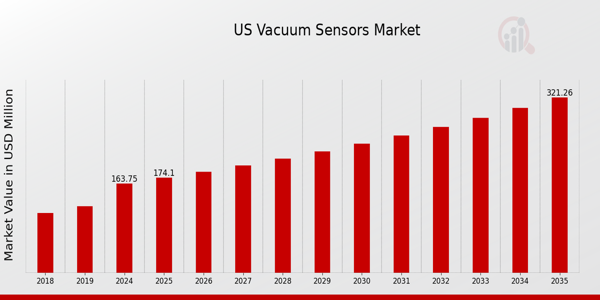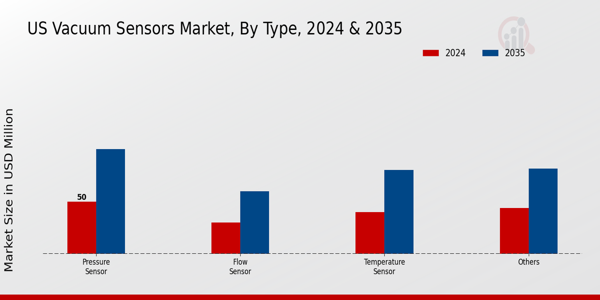US Vacuum Sensors Market Overview:
The US Vacuum Sensors Market Size was estimated at 154.04 (USD Million) in 2023. The US Vacuum Sensors Market Industry is expected to grow from 163.75(USD Million) in 2024 to 321.26 (USD Million) by 2035. The US Vacuum Sensors Market CAGR (growth rate) is expected to be around 6.318% during the forecast period (2025 - 2035).
Key US Vacuum Sensors Market Trends Highlighted
The US Vacuum Sensors Market is experiencing significant growth driven by several key factors. One of the primary market drivers is the increasing demand for vacuum technologies in various sectors, including semiconductor manufacturing, pharmaceuticals, and food processing. The US, being a global hub for these industries, is seeing heightened investment in vacuum systems, which in turn increases the need for advanced vacuum sensors. Additionally, the rising emphasis on automation and smart technologies has led to innovations in sensor technologies, making them more efficient and reliable.
Companies are focusing on integrating IoT capabilities into vacuum sensors, allowing real-time monitoring and data analysis, thus enhancing operational efficiency.
Opportunities in the US Vacuum Sensors Market include the potential for advancements in sensor miniaturization and increased adoption in emerging applications such as renewable energy and electric vehicle manufacturing. As the US government pushes for a transition towards renewable energy, vacuum sensors can play a critical role in research and development labs and manufacturing plants focused on solar panel and battery production. The growing trend towards environmental sustainability is fostering innovation in sensor technologies, creating new avenues for market participants to explore.
Recent trends highlight a shift towards more sophisticated and connected vacuum sensors that can facilitate better performance and integration into automation systems. Moreover, the trend toward customizable solutions tailored to specific industrial needs is becoming prominent, allowing companies to cater to diverse customer requirements. As the US continues to prioritize technological advancements and sustainability, the vacuum sensors market is poised to evolve in response to these changing dynamics.

Source: Primary Research, Secondary Research, MRFR Database and Analyst Review
US Vacuum Sensors Market Drivers
Increased Demand for Advanced Automation
The US Vacuum Sensors Market Industry is witnessing substantial growth due to the rising demand for advanced automation in manufacturing processes. Automation is critical for improving operational efficiency and reducing production costs. According to the U.S. Bureau of Labor Statistics, productivity in the manufacturing sector has seen an increase of approximately 3.5% over the past decade, driven by automation technologies that incorporate vacuum sensors. Major organizations like Rockwell Automation and Siemens are at the forefront of this trend, integrating sophisticated vacuum sensor technologies into their automated systems.
This increasing productivity helps in significantly enhancing throughput and reducing downtime, effectively pushing forward the adoption of vacuum sensors in various industrial applications. As businesses look to streamline their processes, vacuum sensors play an essential role in achieving these automation goals, indicating a strong upward trajectory for the US Vacuum Sensors Market.
Growth in Healthcare and Pharmaceutical Sectors
The healthcare and pharmaceutical sectors in the US are expanding rapidly, which is significantly boosting the US Vacuum Sensors Market Industry. With stringent regulations governing the production of medical devices and drugs, manufacturers are increasingly using vacuum sensors to ensure sterile environments necessary for safe production processes. Data from the National Institutes of Health indicates that healthcare spending in the US is projected to grow by over 5% annually, thereby stimulating investments in manufacturing technologies like vacuum sensors.
Notable corporations, including Johnson & Johnson and Pfizer, have been implementing advanced vacuum monitoring systems to meet these rigorous standards, highlighting the critical role vacuum sensors play in ensuring compliance and operational efficiency in highly regulated sectors.
Technological Advancements and Innovations
Technological advancements in sensor technology are a significant driver of growth in the US Vacuum Sensors Market Industry. The introduction of more accurate and reliable sensors leads to improved performance in various applications, particularly in sectors requiring precise measurements. According to the US Patent and Trademark Office, there has been a steady rise in patents related to sensor technology, suggesting a burgeoning area of innovation. Companies like Honeywell and Emerson Electric are investing heavily in Research and Development to create cutting-edge vacuum sensor solutions, which enhances system functionality and reliability.
This continuous innovation not only meets the growing demands of industries but also opens new avenues for the integration of advanced vacuum sensor technologies in diverse applications across the US.
Regulatory Compliance and Industry Standards
The US Vacuum Sensors Market Industry is positively impacted by the increasing need for regulatory compliance and adherence to industry standards. Stricter regulations governing emissions and waste management necessitate the use of effective monitoring solutions, such as vacuum sensors. The Environmental Protection Agency has implemented regulations aimed at reducing industrial emissions, fostering a growing demand for accurate vacuum measurement technologies to ensure compliance. Leading companies, for example, General Electric and 3M, have recognized this need and are incorporating advanced vacuum sensors into their systems to maintain compliance.
This not only mitigates the risk of regulatory fines but also enhances operational efficiency, thus propelling the growth of the US Vacuum Sensors Market.
US Vacuum Sensors Market Segment Insights:
Vacuum Sensors Market Type Insights
The US Vacuum Sensors Market presents a diverse landscape segmented by Type, encompassing vital components such as Temperature Sensors, Pressure Sensors, Flow Sensors, and Others, each contributing significantly to the industry's functionality and overall growth. Temperature Sensors play a critical role in maintaining operational efficiency across various sectors, notably in semiconductor manufacturing and industrial processes that rely on precise thermal management. These sensors help ensure the integrity of manufacturing environments, reflecting the growing emphasis on automation and quality control within industries in the US.
Conversely, Pressure Sensors are fundamental in applications requiring precise measurement of vacuum levels, crucial for industries ranging from pharmaceuticals to food processing, where maintaining a controlled atmosphere can impact product quality and safety. The relevance of these sensors is further underscored as they align with increasing safety regulations and production standards set by governmental bodies. Flow Sensors also hold significance within the vacuum sensor sector, primarily utilized to monitor gas or liquid flow rates in vacuum systems.
Their function is essential for optimizing process efficiencies, which in turn drives demand as more businesses seek to refine their operational workflows and reduce energy consumption in line with sustainability goals.
Moreover, the catch-all category of Others includes innovative technologies and specialized sensors that address niche requirements across various applications, indicating ongoing advancements and customization in sensor technologies in the US. This segment highlights the adaptability of the market, showcasing its capacity to cater to evolving industry needs, which is essential for maintaining competitive advantages. The collective growth of these segments is fostered by a combination of market trends such as the push for automation, adherence to regulatory standards, and the ongoing transition toward more energy-efficient processes.
Hence, the US Vacuum Sensors Market, segmented by Type, is poised for continued growth, driven by a mix of technological advancements and heightened industrial demand across diverse sectors.

Source: Primary Research, Secondary Research, MRFR Database and Analyst Review
Vacuum Sensors Market Application Insights
The US Vacuum Sensors Market is experiencing steady growth driven by various applications across multiple industries. The importance of vacuum sensors is prominent in the transportation sector, where they are utilized for ensuring the safety and efficiency of vehicle systems. In architecture, vacuum sensors play a critical role in maintaining air quality and comfort in modern building designs. The petroleum industry relies heavily on vacuum technology for extraction and refining processes, making these sensors vital for operational efficiency. Similarly, the chemical sector uses vacuum sensors to monitor and control processes, ensuring product quality and safety.
Other applications, spanning various industries, further augment the relevance and demand for vacuum sensors. As sustainability becomes increasingly important, the push for more efficient systems boosts the adoption of vacuum sensors in diverse industrial applications. Overall, the US Vacuum Sensors Market segmentation highlights the versatility and essential nature of these devices across key sectors, fostering significant market opportunities and innovation.
US Vacuum Sensors Market Key Players and Competitive Insights:
The US Vacuum Sensors Market is a crucial segment within the larger sensor industry, characterized by key players who provide various technologies designed to measure and monitor vacuum levels. This market has seen significant advancements driven by increased demand for efficiency and reliability in industrial processes, as well as the rising adoption of automation in sectors such as pharmaceuticals, semiconductor manufacturing, and food processing. The competitive landscape features a mix of established companies and emerging players, each leveraging technology innovations to differentiate their offerings.
Moreover, with the ongoing shift towards sustainability and energy efficiency, companies are focusing on developing smarter, more precise vacuum sensors that cater to evolving market needs. As a result, there is a notable emphasis on research and development, strategic partnerships, and enhancing customer service to gain competitive advantages.
Emerson Electric has established a strong presence in the US Vacuum Sensors Market through its diverse range of advanced technologies and solutions tailored for various applications. The company leverages its vast experience and deep expertise in industrial automation to provide innovative products that meet stringent performance and reliability standards. Emerson Electric's strengths lie in its commitment to quality and customer support, ensuring that its vacuum sensors deliver optimal performance while helping customers achieve efficiency in their operations. The company also emphasizes integrating its sensors with other automation products, enhancing the overall functionality and user experience.
The competitive positioning of Emerson Electric is further supported by its robust distribution network and strategic investments in research and development, allowing it to respond efficiently to market demands and emerging trends.
Parker Hannifin is another prominent player in the US Vacuum Sensors Market, recognized for its comprehensive portfolio of precision sensors and control solutions. The company’s key products include vacuum pressure sensors that offer high accuracy and reliability for various industrial applications. Parker Hannifin's strong market presence is bolstered by its ability to customize solutions based on specific customer requirements, allowing it to effectively serve multiple sectors, including aerospace, automotive, and manufacturing.
The company's strength lies in its well-established reputation for quality and performance, which is further enhanced through strategic mergers and acquisitions aimed at broadening its technology offerings and market reach. Parker Hannifin consistently invests in innovation and development, enabling it to launch new products that address the evolving challenges faced by its customers in the US. This proactive approach not only reinforces its competitive position but also ensures that it remains at the forefront of the vacuum sensor industry within the country.
Key Companies in the US Vacuum Sensors Market Include:
US Vacuum Sensors Market Industry Developments
In recent months, the US Vacuum Sensors Market has seen significant developments, including rising demand across various sectors such as pharmaceuticals and semiconductors, fueling innovation and growth among leading companies. Emerson Electric and Honeywell have reported increased investments in Research and Development to enhance their product offerings and meet the expanding market needs. Additionally, in May 2023, Parker Hannifin announced its acquisition of a niche vacuum sensor technology firm, bolstering its position in the market and diversifying its product range. MKS Instruments has also experienced a strong valuation growth due to heightened reliance on vacuum technology in manufacturing processes.
Over the past two to three years, challenges such as supply chain disruptions have increased the focus on advanced vacuum solutions, prompting companies like Edwards Vacuum and Sensata Technologies to emphasize sustainability and efficiency in their products. Furthermore, regulatory changes supporting green technologies have facilitated a shift towards more environmentally friendly vacuum sensor solutions, aligning with broader industry trends. This evolving landscape indicates a robust and dynamic market, driven by technological advancements and strategic mergers and acquisitions among key industry players.
US Vacuum Sensors Market Segmentation Insights
Vacuum Sensors Market Type Outlook
Vacuum Sensors Market Application Outlook
| Report Attribute/Metric Source: |
Details |
| MARKET SIZE 2018 |
154.04(USD Million) |
| MARKET SIZE 2024 |
163.75(USD Million) |
| MARKET SIZE 2035 |
321.26(USD Million) |
| COMPOUND ANNUAL GROWTH RATE (CAGR) |
6.318% (2025 - 2035) |
| REPORT COVERAGE |
Revenue Forecast, Competitive Landscape, Growth Factors, and Trends |
| BASE YEAR |
2024 |
| MARKET FORECAST PERIOD |
2025 - 2035 |
| HISTORICAL DATA |
2019 - 2024 |
| MARKET FORECAST UNITS |
USD Million |
| KEY COMPANIES PROFILED |
Emerson Electric, Parker Hannifin, Vacuubrand, Kelvion, Groupe Schneider, Thorlabs, Sensata Technologies, Edwards Vacuum, MKS Instruments, KJL Technologies, Horiba, Honeywell, Siemens, Ametek |
| SEGMENTS COVERED |
Type, Application |
| KEY MARKET OPPORTUNITIES |
Growing demand in pharmaceuticals, Advancements in semiconductor manufacturing, Increased automation in manufacturing, Expansion of renewable energy sector, Focus on energy-efficient solutions |
| KEY MARKET DYNAMICS |
Technological advancements, Growing demand in automation, Stringent regulatory requirements, Increased adoption in healthcare, Rising focus on energy efficiency |
| COUNTRIES COVERED |
US |
Frequently Asked Questions (FAQ):
The US Vacuum Sensors Market is expected to be valued at 163.75 million USD in 2024.
The market is expected to grow at a CAGR of 6.318 percent from 2025 to 2035.
By 2035, the US Vacuum Sensors Market is projected to reach a value of 321.26 million USD.
The market comprises Temperature Sensors, Pressure Sensors, Flow Sensors, and Others.
Temperature Sensors in the US Vacuum Sensors Market are valued at 40.0 million USD in 2024.
By 2035, Pressure Sensors are expected to have the highest market value at 100.0 million USD.
Major players include Emerson Electric, Parker Hannifin, Vacuubrand, and others.
Flow Sensors are anticipated to reach a market value of 60.0 million USD by 2035.
The market faces challenges such as technological advancements and increasing competition.
There are significant opportunities in emerging technologies and increasing industrial automation.















